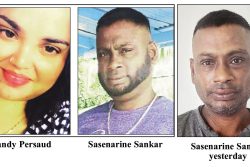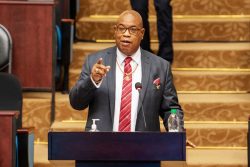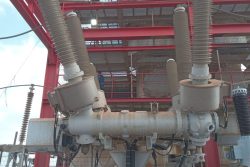Yesterday’s passing of 25-year-old teacher, Donna Greaves at the Georgetown Public Hospital (GPHC) underlines the continuing trauma facing the country from COVID-19.
Mrs Greaves had been flown from Lethem to Georgetown for treatment of a medical condition unrelated to COVID-19. According to her widower, Franklin Greaves, Mrs Greaves had been tested negative for the coronavirus prior to her departure for the GPHC and it is his contention that his wife had picked up the infection at the GPHC.
Needless to say, in the context of an easily transmissible virus, protecting patients from cross-infections in a hospital is vitally important. Since the GPHC has been dealing with this pandemic for roughly six months one would presume that there are clearly defined protocols for preventing cross-infections of patients and that these are rigidly adhered to by health workers and ancillary employees.
Given the infectiousness of COVID-19, protecting patients and those treating them and working in close proximity is not an easy challenge. The GPHC, the COVID-19 Unit and the COVID-19 taskforce must rapidly and comprehensively respond to concerns about the pathway through which Mrs Greaves might have been infected.
It is unclear to what extent the Ministry of Public Health has been able to undertake any investigations of the manner of the spread of the COVID-19 infection across the country since the detection of the first case here. Presuming that the tests for Mrs Greaves in Lethem were true negatives, transportation by air from such a distance to the GPHC posed a significant risk of exposure considering the number of persons who might have been in proximity up to her arrival at the GPHC. Once at the GPHC, where COVID-19 patients are received and treated, the imperative of protecting patients from infection is all-encompassing and a severe challenge.
About one in five of Britain’s patients with COVID-19 caught the virus while in hospital, according to the Daily Telegraph newspaper which cited papers by government scientists. So, it would not be uncommon if Mrs Greaves did contract COVID-19 at the hospital. GPHC should undertake an immediate audit of the handling of Mrs Greaves and must take the required precautionary measures in relation to those who had been treating her and had been in proximity to her. It must at some point provide the public with a considered response.
Aside from this latest death, the third in short order, the country is battling COVID-19 on several fronts. Moruca in Region One has now become the epicentre. There are a variety of factors at play here including the apparent mindset of some in the region that COVID-19 is a hoax. Were this indeed the case, the village councils, the regional council and the Ministry of Public Health must undertake a full-scale education campaign in the affected areas. There must be investment in spreading the word about the devastation that this virus can cause.
There also appeared to be insufficient attention to precautionary measures such as use of face masks and social distancing. A high number of teachers were infected as a result of activities that put them in close proximity to each other and thereafter possibly spreading the virus to their families.
There are other weaknesses in the national response that have exacerbated matters. Not for the first time since testing for COVID-19 began, Stabroek News has received reports that test results have not been received in good time and this has raised the possibility that infected persons unaware of their status could have continued their routines creating the risk of further infections.
Yesterday’s Sunday Stabroek reported on the case of a 69-year-old man who said that he was tested on June 21st along with several teachers. At that time, he said he had a persistent cough and because of that he was told that he would have to be tested.
Over the next two to three days, he stated, the teachers received their results and were placed in isolation as they were positive. However, he was told nothing.
In the meantime, he said, he decided to self-isolate and devised his own medicine to get rid of the cough. He added that he assumed that not receiving his result meant that he didn’t have the disease. However, on July 4th, the man said he was very shocked when he saw the bus that collects COVID-19 patients in front of his home. He said when he approached the bus, the occupants told him that officials from the hospital had sent them to collect him because he was positive. The man said that he asked why he was receiving his results 13 days after he was tested but he didn’t receive a response. Luckily, he had not left his home during the period. The COVID-19 task force must immediately seek to ensure that results of tests are quickly relayed and that during the waiting period the persons in question are quarantined.
The mining area of Aranka/Arangoy Landing in Region Seven has now become a zone of concern after several positive results for the virus. This area has been placed under lockdown – no one in and no one out. The COVID-19 task force has not seriously addressed concerns that have been raised about the risk of the spread of the virus posed by the peripatetic nature of mining and the movement of people and supplies in close proximity to communities. The authorities must immediately move to restrict operations in any areas where there is a risk of transmission of COVID-19 to nearby communities.
Reservations continue to be expressed about quarantine and isolation facilities. If these continue to be sub-par in places like Moruca and Aranka there will be further complications as people will opt not to report symptoms and be tested for fear of having to be kept at one of these facilities. This is a matter that has been repeatedly raised with the health authorities. They need to urgently invest in better facilities in association with the private sector and other stakeholders.
The failures that have occurred cannot be reversed. The reality remains that despite months of lockdown the COVID-19 infection curve has not been flattened and the virus has now been detected in nine of the 10 regions. It can only be contained by stepping up the best known strategies: broad testing, isolation and contact tracing. It is unclear – as it has been from the start of this campaign – how much contact tracing is being done by the health authorities but there cannot be any compromise on this. Whether paid or unpaid – dozens will have to be hired in the various regions and trained to conduct contact tracing with immediate referrals being made for testing. There is no other option at this point in bringing COVID-19 under control.






